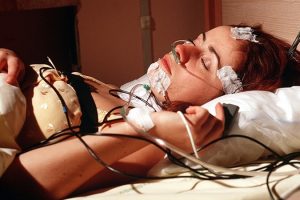Heart Rate-Based Algorithm Feasible to Define Sleep Stage at Home

The study covered in this summary was published in medRxiv.org as a preprint and has not yet been peer reviewed.
Key Takeaways
-
HR-based sleep staging provides a feasible solution for sleep assessment that can be done at home.
-
Validation results from two databases show high and consistent accuracy, suggesting electrocardiogram (ECG) wearable devices paired with sleep staging algorithms are an accessible method for monitoring sleep.
Why This Matters
-
Less than 20% of Americans with sleep-related problems are properly diagnosed and treated.
-
There is a need for sleep monitors that could be used at home as well as automated solutions to perform reliable sleep stage scoring.
-
The purpose of this study was to assess the validity of Neurobit-HRV Deep Learning models for automatic sleep staging.
Study Design
-
The authors studied HR-based automated sleep staging software called Neurobit-HRV (Neurobit Inc, New York City).
-
Sleep state classification was performed at 2-levels (wake; sleep), 3-levels (wake; NREM; REM) or 4-levels (wake; light; deep; REM) in 30-second epochs.
-
Using polysomnography (PSG) recordings from the open-source PhysioNet Computing in Cardiology (CinC) dataset and HR recordings from the proprietary Z3Pulse dataset, the authors evaluated the performance of the models using accuracy (A), Cohen’s kappa (K), sensitivity (SE), specificity (SP), positive predictive value (PPV) and negative predictive value (NPV).
Key Results
-
In both the CinC and Z3Pulse datasets similarly, the highest value of accuracy was achieved by the 2-levels model (0.8797 and 0.8812, respectively) and the 3-levels model obtained the best value of K (0.6025 and 0.611, respectively).
-
In the CinC dataset, the 4-levels model obtained the lowest value of SE (0.3812) and the highest value of SP (0.9744) for the classification of DEEP sleep segments and the Z3Pulse demonstrated SE (0.6163) and the highest value of SP (0.9606) was found across the DEEP sleep segment.
Limitations
-
The limited sample size of the Z3Pulse dataset did not allow for analyses stratified by age, apnea-hypopnea index score, and gender.
-
The results showed that the performance of the algorithm was associated with participants’ age. Therefore, additional data collection across age groups are anticipated.
Disclosures
-
Authors Amiya Patanaik and Kishan Kishan are shareholders in Neurobit Inc.
-
This work was supported by grants from the Health Technology Consortium grant.
This is a summary of a preprint research study “An automated heart rate-based algorithm for sleep stage classification: Validation using conventional PSG and innovative wearable ECG device” written by CAPACITY-COVID collaborative consortium and LEOSS Study Group from University Medical Center Utrecht on MedRxiv and provided to you by Medscape. This study has not yet been peer reviewed. The full text of the study can be found on medRxiv.org.
Source: Read Full Article